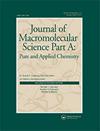烯烃聚合的新趋势:展望
IF 2.4
3区 化学
Q3 POLYMER SCIENCE
Journal of Macromolecular Science Part A-Pure and Applied Chemistry
Pub Date : 2023-10-22
DOI:10.1080/10601325.2023.2269971
引用次数: 0
摘要
摘要烯烃聚合这一看似成熟的领域,在满足当代材料需求方面仍面临着一些挑战,并具有巨大的潜力。在这篇专题文章中,我们研究了近二十年来烯烃聚合的进展。在几个新兴趋势中,我们确定了四个最具影响力的发现,即:(i)解结超高分子量聚乙烯(dUHMWPE), (ii)双取代功能烯烃共聚,(iii)生物衍生共聚体在聚烯烃中的掺入,以及(iv)上述(ii, iii)功能聚烯烃作为相容剂的应用。dUHMWPE引起了广泛的关注,非均相齐格勒型催化剂、均相茂金属催化剂和后茂金属催化剂已被报道用于制备脱缠超高分子量聚乙烯。双官能二取代烯烃的插入共聚反应最近才有报道,邻膦苯磺酸钯催化剂的催化性能优于其他催化剂。有趣的是,生物衍生烯烃的插入共聚已经见证了报告数量的激增。糖和植物油衍生的烯烃已与乙烯共聚得到相对亲水的聚乙烯。功能性聚乙烯正在寻找一种新的应用,作为相容剂或显示更好的表面附着力。因此,这篇专题文章简要介绍了聚烯烃的新兴趋势,确定了最具影响力的贡献,并讨论了这些新材料的应用潜力。关键词:插入(co)聚合;超高分子量聚乙烯;功能化聚乙烯;我们感谢DST-SERB (CRG/2021/005385)、CSIR-NCL (HCP46)和DSIR (CRTDH@NCL)印度的资金支持。RSB感谢DST提供DST- inspire奖学金。DVB和PG感谢教资会提供奖学金。本文章由计算机程序翻译,如有差异,请以英文原文为准。
Emerging trends in olefin polymerization: a perspective
AbstractThe seemingly matured field of olefin polymerization still poses several challenges and holds enormous potential to meet contemporary material requirements. In this feature article, we examine the progress of olefin polymerization in the last two decades. Among the several emerging trends, we identify four most impactful discoveries, namely, (i) disentangled ultra-high molecular weight polyethylene (dUHMWPE), (ii) disubstituted functional olefin copolymerization, (iii) incorporation of bioderived comonomers in polyolefins, and (iv) application of above (ii, iii) functional polyolefins as compatibilizers. The dUHMWPE has attracted significant attention and heterogeneous Ziegler-type catalysts, homogenous metallocene, and post-metallocene catalysts have been reported to produce disentangled ultrahigh molecular weight polyethylene. Insertion copolymerization of difunctional disubstituted olefins has been reported only recently and ortho-phosphinobenzene sulfonate palladium catalyst outperforms the other catalysts. Interestingly, insertion copolymerization of bioderived olefins has witnessed a surge in the number of reports. Sugar and plant oil-derived olefins have been copolymerized with ethylene to obtain relatively hydrophilic polyethylene. The functional polyethylene is finding a new application as compatibilizer or displays better adhesion to surfaces. Thus, the feature article offers a succinct account of emerging trends in polyolefins, identifies the most impactful contributions, and debates the application potential of these new materials.Keywords: Insertion (co)polymerizationuHMWPEfunctional polyethylenerenewable monomerscompatibilizer Disclosure statementNo potential conflict of interest was reported by the author(s).Additional informationFundingWe gratefully acknowledge the financial support from DST-SERB (CRG/2021/005385), CSIR-NCL (HCP46), and DSIR (CRTDH@NCL) India. RSB is thankful to DST for the DST-INSPIRE fellowship. DVB and PG are thankful to UGC for the fellowship.
求助全文
通过发布文献求助,成功后即可免费获取论文全文。
去求助
来源期刊
CiteScore
4.60
自引率
16.00%
发文量
61
审稿时长
3.1 months
期刊介绍:
Journal of Macromolecular Science, Part A: Pure and Applied Chemistry (JMS-PAC) is a necessary resource for academic and industrial scientists and engineers whose interests center on both synthetic and naturally occurring polymers and their applications.

 求助内容:
求助内容: 应助结果提醒方式:
应助结果提醒方式:


